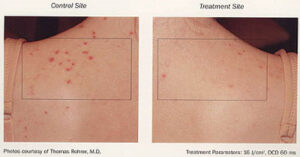Acne
About Acne
What is it?
Affecting more than 50 million Americans, acne is the most common skin problem in the country. Acne is the result of clogged pores that eventually become small red bumps, or pimples, which can be characterized as blackheads, whiteheads, cysts, pustules, and more. While these blemishes commonly appear on your face, they also can develop on the neck, shoulders, upper arms, chest, back, and buttocks.
What causes it?
When the clogging in your pores builds up too much, they become a breeding ground for P. acnes, the bacteria that cause pimples to develop. However, it’s important to remember what doesn’t cause acne: stress, fried foods and other poor diet choices, poor hygiene, and hormones. While it is true that these things can worsen your acne, there is no truth to the myth that they actually cause the condition.
Common treatments?
Many acne treatments are available, but their efficacy can differ from person to person; what works for you may not work for someone else. Furthermore, some medications and treatments are more effective for milder cases of the condition, while other treatments are better for severe breakouts. Mild or moderate cases of acne (i.e., a few blemishes, whiteheads, and/or blackheads) can be erased with simple over-the-counter medications with benzoyl peroxide, retinoids, or salicylic acid. However, for severe acne cases (red, swollen, often painful blemishes consisting of cysts and/or nodules), an array of treatments can work: these include prescription-strength topical or oral medications, antibiotics to destroy the acne-causing bacteria, a variety of light therapies (including lasers), chemical peels, and drainage and extraction procedures for the most stubborn acne.
Providers
Our approach & expertise
Before and After


